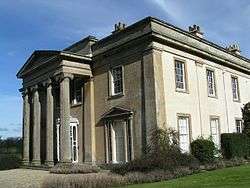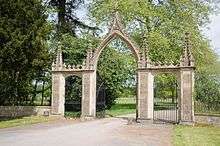Clytha Park
| Clytha Park | |
|---|---|
 "one of the best neo-classical houses in Wales" | |
| Type | House |
| Location | Clytha, Monmouthshire |
| Coordinates | 51°46′35″N 2°55′09″W / 51.7763°N 2.9193°WCoordinates: 51°46′35″N 2°55′09″W / 51.7763°N 2.9193°W |
| Built | 1820-8 |
| Architect | Edward Haycock |
| Architectural style(s) | Neo-classical |
| Governing body | National Trust |
Listed Building – Grade I | |
| Official name: Clytha Park | |
| Designated | 9 January 1956 |
| Reference no. | 1941 |
Listed Building – Grade II* | |
| Official name: Gateway and railings to Clytha Park | |
| Designated | 9 January 1956 |
| Reference no. | 1967 |
 Location of Clytha Park in Monmouthshire | |
Clytha Park, Clytha, Monmouthshire, is a 19th-century Neoclassical country house, "the finest early nineteenth century Greek Revival house in the county." The wider estate encompasses Monmouthshire's "two outstanding examples of late eighteenth century Gothic", the gates to the park and Clytha Castle. The owners were the Jones family, later Herbert, of Treowen and Llanarth Court. It is a Grade I listed building.
History
The original house on the site, Clytha House, was built by the Berkeley family of Spetchley Park in Worcestershire.[1] It was subsequently purchased by William Jones the Elder, who constructed the gates and Clytha Castle.[1] His son, William Jones the Younger, from 1862 Herbert,[1] razed the Georgian mansion to the ground and replaced it with the Neoclassical Clytha Park.[1] The Monmouthshire antiquarian Sir Joseph Bradney records that Jones's attempts to change his name to Herbert occasioned a long feud with his near neighbour, Lord Llanover, the Lord Lieutenant of Monmouthshire, who sought to block the change;[2] "A long and acrimonious, and at times highly humorous, correspondence ensued in the newspapers and a debate on the subject took place in the house of commons".[2]
Beginning work on his inheritance in 1820, Jones used the Shrewsbury architect, Edward Haycock Snr.[1] In the later 19th century, the house contained the painting, The Deluge by Francis Danby.[1] A service wing at the rear of the house was demolished in 1957. Although owned by the National Trust, the house remains the private residence of the Hanbury-Tenison family[3] and is accessible only by prior written appointment.[4]

The wider estate encompasses Monmouthshire's "two outstanding examples of late eighteenth century Gothic",[5] the gates to the park and Clytha Castle. Overlooking the house, on a prominent hill, stands the folly of Clytha Castle, constructed by William Jones the Elder in memory of his wife.[2] Long attributed to John Nash, recent documentary discovery has shown that it was designed by John Davenport,[6] who also laid out the grounds, a "well-preserved (example of) a late eighteenth century landscape park".[7] The original canal in the grounds by Davenport was extended in the early 19th century to create the present lake, the spoil from the excavations being used to create a raised platform for the new house.[8] The park was further developed by Henry Avray Tipping in the early 20th century.[9]
On the old Abergavenny-to-Raglan road stand the entrance gates, again reputedly by John Nash,[5] who did undertake work in South Wales. A lodge is set to one side. They are earlier than the house, of 1797.[5] The entry in Mee's The King's England suggests that the gateway came from the ruined mansion of Perth-hir,[10] near Rockfield.[11] The gates have their own Grade II* listing.[12]
Architecture and description
The architectural historian John Newman considers Clytha, "the finest early nineteenth century Greek Revival house in the county."[5] The building is a square in the Greek Doric style, of ashlar with sandstone dressings.[5] It is of two storeys and has a "fine centr(al) sandstone Ionic tetrastyle portico".[1] The interior is pure Doric, with a circular vestibule leading to a spacious, top-lit,[13] staircase hall.[6] Peter Smith, in his 1975 (2nd edition 1988) study, Houses of the Welsh Countryside, describes Clytha as "represent(ing) the best of the Greek revival".[13] The court was designated a Grade I listed building on 1 September 1956.[14] Cadw's listing describes Clytha Park as "one of the best neo-classical houses in Wales".[1]
Notes
- 1 2 3 4 5 6 7 8 "Listed Buildings - Full Report - HeritageBill Cadw Assets - Reports". cadwpublic-api.azurewebsites.net.
- 1 2 3 Bradney 1992, pp. 116-17.
- ↑ London Gazette, issue no.47892, 28 June 1979
- ↑ "Clytha Estate". National Trust. Retrieved 2017-04-11.
- 1 2 3 4 5 Newman 2000, p. 190.
- 1 2 Newman 2000, p. 191.
- ↑ "CLYTHA PARK, GARDEN, ABERFFRWD | Manylion y Safle". Coflein. Retrieved 2012-02-12.
- ↑ Attlee 2009, p. 92.
- ↑ "Clytha Park". www.parksandgardens.org.
- ↑ "PERTH-HIR RUINS, ROCKFIELD; PERTHYRE, MANSION, REMAINS OF - Coflein". www.coflein.gov.uk.
- ↑ Tyerman & Warner 1951, p. 58.
- ↑ Good Stuff IT Services (1956-09-01). "Gateway and railings to Clytha Park - Llanarth - Monmouthshire - Wales". British Listed Buildings. Retrieved 2012-02-12.
- 1 2 Smith 1988, p. 322.
- ↑ Good Stuff IT Services (1956-09-01). "Clytha Park - Llanarth - Monmouthshire - Wales". British Listed Buildings. Retrieved 2012-02-12.
References
- Attlee, Helena (2009). The Gardens of Wales. London: Frances Lincoln. ISBN 978-0-7112-2882-5.
- Bradney, Joseph (1992). A History of Monmouthshire: The Hundred of Raglan, Volume 2 Part 1. Academy Books. ISBN 1-873361-15-7.
- Newman, John (2000). Gwent/Monmouthshire. The Buildings of Wales. London: Penguin. ISBN 0-14-071053-1.
- Smith, Peter (1988). Houses of the Welsh Countryside. London: Her Majesty's Stationery Office. ISBN 9-78011-300012-8.
- Tyerman, Hugo; Warner, Sydney (1951). Arthur Mee, ed. Monmouthshire: A Green and Smiling Land. The King's England. London: Hodder & Stoughton. OCLC 906097367.